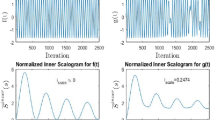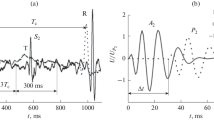Abstract
The optimal duration of the time-window used to compute the time-frequency representation (spectrogram) of the phonocardiogram was studied in four dogs by using intracardiac and thoracic measurements of the PCG. The power and cross-spectrograms of the intracardiac and thoracic PCGs were computed using a fast Fourier transform algorithm and a sine-cosine window with 10 per cent decaying functions. A coherence spectrogram was also computed for each dog to study the linear relationship between the two signals and determine the optimal time-window duration. Results show that the optimal range of the time-window duration is between 16 and 32 ms. A time-window shorter than 16ms spreads out low-frequency components into the higher frequencies and generates a spectrographic representation with poor frequency resolution (≥62·5 Hz). A window larger than 32 ms increases the frequency resolution but smears the spectrographic representation of the signal in the time domain and thus cannot correctly reflect the time-varying properties of the signal. In both cases, the amplitude of the coherence function computed between the left ventricular and the thoracic phonocardiograms is overestimated.
Similar content being viewed by others
References
Aigner, V. A., Muller, G., Knapp, E. andRaas, E. (1973) Schallspektrographische Untersuchungen an Starr-Edwards-Aortenklappenprothesen.Z. Kardiol.,62, 1105–1113.
Aigner, V. A. (1977) Kontursonagraphische Analysen von Herzschall-Phanomenen und Tonen verschiedener Klappenprothesen.Fortschr. Med.,95, 2162–2166.
Cooley, J. W. andTukey, J. W. (1965) An algorithm for the machine calculation of complex Fourier series.Math. Comput.,19, 297–301.
Durand, L.-G. andGuardo, R. (1982) A model of the heart-thorax acoustic system. InApplications of computers in medicine.Schwartz, M. D. (Ed.) IEEE, California, 29–41.
Durand, L.-G., Genest, J. andGuardo, R. (1985) Modeling of the transfer function of the heart-thorax acoustic system in dogs.IEEE Trans.,BME-32, 592–601.
Durand, L.-G. andGuardo, R. (1986) Comparison of air and contact microphones for estimating the acoustic transmission of heart sounds in dogs.Innov. Tech. Biol. Med.,7, 458–473.
Durand, L.-G., Langlois, Y.-E., Lanthier, T., Chiarella, R., Coppens, P., Carioto, S. andBertrand-Bradley, S. (1990a) Spectral analysis and acoustic transmission of mitral and aortic valve closure sounds in dogs. Part 1: Modelling the heart/thorax acoustic system.Med. & Biol. Eng. & Comput.,28, 269–277.
Durand, L.-G., Langlois, Y.-E., Lanthier, T., Chiarella, R., Coppens, P., Carioto, S. andBertrand-Bradley, S. (1990b) Spectral analysis and acoustic transmission of mitral and aortic valve closure sounds in dogs. Part 2: Effects of neuromuscular blockade, sternotomy and pacemaker control, and a two-week recovery period. —Ibid.28, 278–286.
Durand, L.-G., Langlois, Y.-E., Lanthier, T., Chiarella, R., Coppens, P., Carioto, S. andBertrand-Bradley, S. (1990c) Spectral analysis and acoustic transmission of mitral and aortic valve closure sounds in dogs. Part 3: Effects of altering heart rate and P-R interval. —Ibid.,28, 431–438.
Durand, L.-G., Langlois, Y.-E., Lanthier, T., Chiarella, R., Coppens, P., Carioto, S. andBertrand-Bradley, S. (1990d) Spectral analysis and acoustic transmission of mitral and aortic valve closure sounds in dogs. Part 4: Effects of modulating cardiac inotropy. —Ibid.,28, 439–445.
Geckeler, G. D., Likoff, W., Mason, D., Riesz, R. R. andWirth, C. H. (1954) Cardiospectrograms.Am. Heart J. 48, 190–196.
Hylen, J. C., Kloster, F. E., Herr, R. H., Starr, A. andGriswold, H. E. (1969) Sound spectrographic diagnosis of aortic ball variance.Circ.,39, 849–858.
Iwata, A., Suzumura, N. andIkegaya, K. (1977) Pattern classification of the phonocardiogram using linear prediction analysis.Med. Biol. Eng. & Comput.,15, 407–412.
McKusick, V. A. (1959) Spectral phonocardiography.Am. J. Cardiol.,4, 200–206.
Portnoff, M. R. (1980) Time-frequency representation of digital signals and systems based on short-time Fourier analysis.IEEE Trans.,ASSP-28, 55–68.
Potter, R. K., Kopp, G. A. andGreen, H. C. (1947)Visible speech, 1st edn. D. Van Nostrand Co., Inc., New York.
Winer, D. E., Perry, L. W. andCaceres, C. A. (1965) Heart sound analysis: a three dimensional approach.Am. J. Cardiol.,16, 547–551.
Author information
Authors and Affiliations
Rights and permissions
About this article
Cite this article
Jamous, G., Durand, L.G., Langlois, Y.E. et al. Optimal time-window duration for computing time/frequency representations of normal phonocardiograms in dogs. Med. Biol. Eng. Comput. 30, 503–508 (1992). https://doi.org/10.1007/BF02457829
Received:
Accepted:
Issue Date:
DOI: https://doi.org/10.1007/BF02457829




